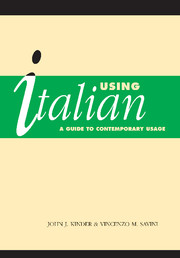Book contents
- Frontmatter
- Contents
- Preface and acknowledgments
- Abbreviations
- 1 Varieties of language
- WORDS AND THEIR MEANINGS
- THE CLAUSE – combining words
- 14 Gender
- 15 Number
- 16 Pronouns
- 17 Comparison
- 18 Word order
- 19 Negation
- 20 Periphrases
- 21 Verbs of movement
- 22 Auxiliary verbs in compound tenses
- 23 The passive
- 24 Reflexives and impersonals
- THE SENTENCE – combining clauses
- TEXTS AND THEIR STRUCTURE
- Bibliography
- Italian word index
- Grammar index
17 - Comparison
Published online by Cambridge University Press: 05 June 2012
- Frontmatter
- Contents
- Preface and acknowledgments
- Abbreviations
- 1 Varieties of language
- WORDS AND THEIR MEANINGS
- THE CLAUSE – combining words
- 14 Gender
- 15 Number
- 16 Pronouns
- 17 Comparison
- 18 Word order
- 19 Negation
- 20 Periphrases
- 21 Verbs of movement
- 22 Auxiliary verbs in compound tenses
- 23 The passive
- 24 Reflexives and impersonals
- THE SENTENCE – combining clauses
- TEXTS AND THEIR STRUCTURE
- Bibliography
- Italian word index
- Grammar index
Summary
Comparison of inequality (more/less/fewer than)
Usage varies somewhat in the use of di and che.
Nouns and pronouns
If two nouns or pronouns are compared and one of them comes before the verb, di is used. This usually means that both items are subjects of a verb, expressed or implied, e.g.:
Le riviste sono più/meno care dei giornali.
Magazines are more/less expensive than newspapers.
Mio fratello ha due anni più/meno di me.
My brother is two years older/younger than I/me.
Le nuove banconote sono più/meno belle di quelle vecchie.
The new banknotes are more/less beautiful than the old ones.
If the two nouns or pronouns being compared both come after the verb, che is used (though di may also be found in this position). This usually means that both items are objects of a verb. Compare the following pairs of sentences:
Mangio più past a che riso.
La pasta la mangio più del riso.
I eat more pasta than rice.
R1* vulgar or indecent
R1 informal, colloquial
R2 neutral, unmarked
R3 formal, written Italian words and expressions are R2 unless otherwise indicated. See also p. 5.
- Type
- Chapter
- Information
- Using ItalianA Guide to Contemporary Usage, pp. 270 - 275Publisher: Cambridge University PressPrint publication year: 2004



